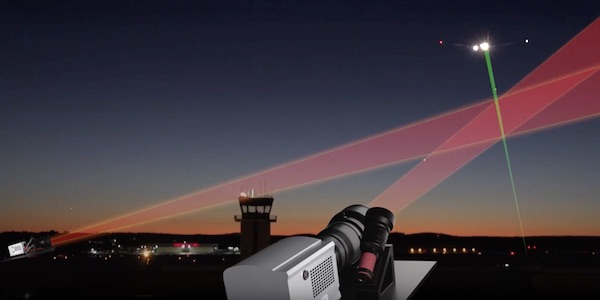Home
A comprehensive resource for safe and responsible laser use
US: MIT develops laser to deliver secret audio messages
Their paper describing this, "Photoacoustic communications: delivering audible signals via absorption of light by atmospheric H₂O", was published in January 2019. The abstract is as follows:
We describe a means of communication in which a user with no external receiver hears an audible audio message directed only at him/her. A laser transmits the message, which is encoded upon a modulated laser beam and sent directly to the receiver’s ear via the photoacoustic effect. A 1.9 μm thulium laser matched to an atmospheric water vapor absorption line is chosen to maximize sound pressure while maintaining eye-safe power densities. We examine the photoacoustic transfer function describing this generation of audible sound and the important operational parameters, such as laser spot size, and their impact on a working system.
The laser is said to be eye- and skin-safe. The system can currently send a sound up to 60 dB across a distance of 2.5 meters (8 feet). In the future they are hoping for a range of 100-500 meters (328-1,640 feet). It is useful for applications as diverse as notifying one person in a crowd, and for headphone-free listening. MIT is patenting the technology.
From R. Sullenberger, S. Kaushik, and C. Wynn, "Photoacoustic communications: delivering audible signals via absorption of light by atmospheric H₂O," Opt. Lett. 44, 622-625 (2019). A PDF of the article is here. News stories about this appeared in numerous publications including Digital Trends, Photonics.com and The Sun.
US: MIT develops system to locate laser perpetrators using as few as two cameras, from miles away
The Laser Aircraft Strike Suppression Optical System (LASSOS) uses two or more low-light CCD sensor cameras that observe the night sky, each with a star tracker that determines the attitude of the sensor. The cameras observe a volume of airspace such as around an airport. Beam locations are identified by analyzing the two (or more) different views to find the endpoint of the laser beam.

In one test, LASSOS identified the ground location of a laser beam aimed into the sky, using two cameras located nine nautical miles away. The locations was determined within 30 seconds. The system was so accurate that it could differentiate between locations separated by only 5 meters.
A key attribute of LASSOS is that the final output is a Google Earth map with the beam and perpetrator location overlaid. This makes it easy for law enforcement to know the area they will be searching for the perpetrator.
An MIT press release gave no indication of potential installation and operational costs, and did not indicate any further plans for testing or implementation.
LASSOS was developed under Air Force Contract No. FA8721-05-C-0002 and/or FA8702-15-D-0001.
From a September 2017 MIT Lincoln Laboratory press release, reprinted below (click the “read more” link.) MIT also has a YouTube video of the system; the LASSOS description begins about 56 seconds into the video. Thanks to Greg Makhov, who brought this to our attention via a Tech Briefs article printed in January 2018.
Australia: Ban on laser pointers has been a "detriment" to safety
The author, Trevor Wheatley, is chair of the Standards Australia SF-019 Committee on laser safety. He studied 41 lasers purchased online in 2012 that were claimed by the sellers to be legal -- lower than the Australian import limit of 1 milliwatt. Most cost less than AUS $20.
Wheatley found that 95% of these pointers were illegal under Australian law, with outputs above 1 mW. Of the 41, 78% were between 5 mW and 100 mW. (5 mW is generally taken to be the highest safe power for a general purpose laser pointer.)
Based on Wheatley's research, "...there would appear to be a greater than 50% chance that someone attempting to buy a 'safe' laser pointer would inadvertently get a hazardous laser." Further, 100% of the tested laser pointers below $20 "would represent prohibited weapons in most Australian states."
From other statistics, the paper states that "availability has not been significantly impacted." In 2007/2008 there were 648 incidents involving lasers pointed at aircraft. In 2010/2011, well after the import and possession restrictions, the number of incidents had increased to 828.
Click to read more...